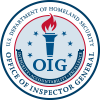We determined that U.S. Customs and Border Protection’s (CBP) training approach and execution do not fully support the canine teams’ mission to detect smuggling of illegal narcotics, agriculture products, and humans at and between ports of entry. In fiscal year 2019, CBP decided to realign its Canine Academy, which contributed to a decrease in canine teams trained in the first two quarters of FY 2020. Office of Field Operations (OFO) canine teams used pseudo narcotic training aids past the recommended replacement cycle. Both Border Patrol and OFO canine teams used outdated actual narcotic training aids during proficiency training in the field. Additionally, OFO canine team files did not have required documentation for proficiency training. Furthermore, CBP’s inadequate governance of canine team operations led to outdated Canine Program policies and procedures, inconsistent retention periods for training documents, and an absence of Canine Tracking System policies and procedures. We recommended that the Office of Training and Development (OTD) Assistant Commissioner develop a comprehensive assessment of the Canine Program realignment to ensure implementation according to OTD training standards. Furthermore, we recommended the Border Patrol Chief and OFO Executive Assistant Commissioner ensure their Canine Programs have enough certified canine instructors and adequate training aids to provide proficiency training for canines after they are deployed. In total, we made four recommendations that, if implemented, should help CBP improve oversight of its Canine Program, formalize and implement a realignment plan for the training academy, provide proper training capabilities, and update and standardize program guidance. CBP concurred with all our recommendations.
Open Recommendations
| Recommendation Number | Significant Recommendation | Recommended Questioned Costs | Recommended Funds for Better Use | Additional Details | |
|---|---|---|---|---|---|
| 2 | No | $0 | $0 | ||
| We recommend the U.S. Border Patrol Chief and Office of Field Operations Executive Assistant Commissioner ensure the Canine Program has enough certified canine instructors and adequate training aids to provide proficiency training for canines after they are deployed. This should include:• implementing a process to ensure sufficient staff are available to provideall training needs to U.S. Border Patrol and the Office of Field Operationscanine teams; and• creating a systemic schedule and plan for pseudo and actual narcoticreplacement for every U.S. Border Patrol sector and Office of FieldOperations field office within the time recommended by the Laboratoriesand Scientific Services Directorate. (See Recommendation 3.) | |||||
| 3 | No | $0 | $0 | ||
| We recommend the Executive Director of the Laboratories and Scientific Services Directorate conduct a study to determine the appropriate time for replacement of pseudo and actual narcotics to limit the constant expiration of these training aids. Pseudo and actual narcotic replacement cycles should be updated according to the results of the Laboratories and Scientific Services Directorate study. | |||||
| 4 | No | $0 | $0 | ||
| We recommend the U.S. Border Patrol Associate Chief of Law Enforcement Operations and Office of Field Operations Director of Tactical Operations update the Canine Program policies to provide adequate oversight to ensure program needs are being met. The policies should include:• record retention timelines for all training documents to beconsistent with the CBP Records General Schedule or provideadequate documentation on retention policies after consultationwith record retention personnel to determine the appropriateapproach;• a systematic schedule and plan for pseudo and actual narcotictraining aids (see Recommendation 2.); and• development of standard operating policies, procedures, andquality assurance measures for use of the Canine TrackingSystem. | |||||


